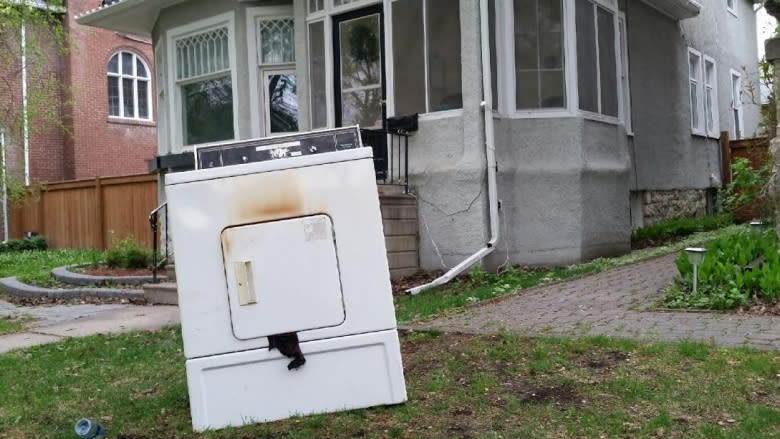Dryer fires a real hazard that can happen at a moment's notice
It was something Ryan Stevens never even considered a possibility until it happened to him.
"If I wouldn't have caught it when I did, I'm pretty sure the house would have burned down," the Halifax resident told CBC News about his experience with a dryer fire.
Stevens said he was taking a shower one night before bed when he smelled something "funny" and went to investigate. When he got to the basement of his townhouse, he discovered smoke coming from the back of his dryer.
He unplugged the machine and when he pulled it away from the wall, flames started shooting from it.
"It was a pretty bad fire. I was definitely scared. I had that moment of, 'I can't believe this is happening,'" Stevens said.
Proactive steps needed
Unable to put out the fire himself, Stevens called 911. Firefighters were able to control it and prevent significant damage.
Stevens said his dryer was from the late '80s or early '90s and while he cleaned the lint trap frequently and the vent occasionally, he never knew lint could build up inside the dryer.
"I didn't realize there was actually a gigantic amount of lint inside the dryer itself," he said. "The fire department opened it up for me and you could see that there was a massive amount of lint in there."
Lint buildup inside a dryer can be a potential fire hazard, according to David Longley, a technician with Appliance Maritimes who's been in the business for 22 years.
He said if lint gets inside around thermostats, motors or heating elements, it can catch fire so it's a good idea to have the interior of the dryer checked periodically.
What can cause lint buildup inside machine?
"The worst that I've seen are four, five, six inches of lint covering the whole bottom of the dryer and that's normally because you've got a clogged vent," he said.
Longley said that happens when the dryer is pushed too tightly back against the wall or when the piping has a kink, resulting in the air backing up into your dryer and lint building up over time.
None of this is news to firefighters in the Halifax Regional Municipality who respond, on average, to 10 dryer fires a year, resulting in everything from smoke to the loss of a home.
"I don't think everybody's aware of the need to be proactive because we're still seeing fires," said Matt Covey, fire prevention division chief with Halifax Regional Fire and Emergency.
Elsewhere in Canada, Fredericton reports an average of three dryer fires a year, Charlottetown an average of five, Vancouver sees about 18 each year, and Toronto has an average 39 annually.
There are telltale signs it may be time to check your dryer, Covey said.
"If you notice any decrease in performance, [if] it's getting too hot or it's not hot enough, that's probably an indication that you have a problem down the line so investigate that promptly."
Safe dryer vents essential
Homeowners must also be cautious about the type of dryer vent they use, Covey said. "White plastic is never recommended for a dryer because it's designed for a bathroom fan/vent," he said.
Halifax Regional Fire and Emergency demonstrated the flammability of three types of venting to show which was safest.
"Not only does the vinyl burn very quickly but it exposes the fire to everything around it, which could set your wall on fire or whatever you have around your dryer," Covey said, adding vinyl also falls into a clump of burning material that will burn for a while.
Covey said while light aluminum is CSA approved, he recommends the heavier aluminum, which will provide better protection. He also recommends having your dryer checked and your vent cleaned once a year.
Longley agrees.
"If you haven't been cleaning your vents and you're just listening to this now, in all likelihood, it's probably a mess inside your dryer. And to be safe you should be looking inside or having a qualified technician look inside and cleaning out what's in there because that is just going to continue to build up over time," Longley said.
Covey also suggests people install a smoke detector in the area where their dryer is located so homeowners are alerted as soon as a fire starts.
If natural gas powers the dryer, he suggests a combination smoke/carbon monoxide detector be used.




